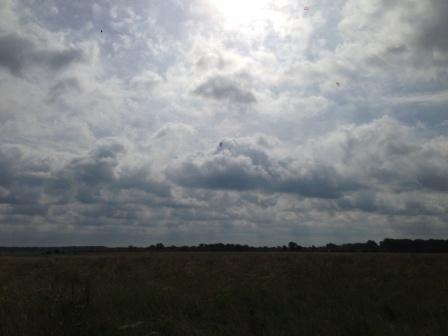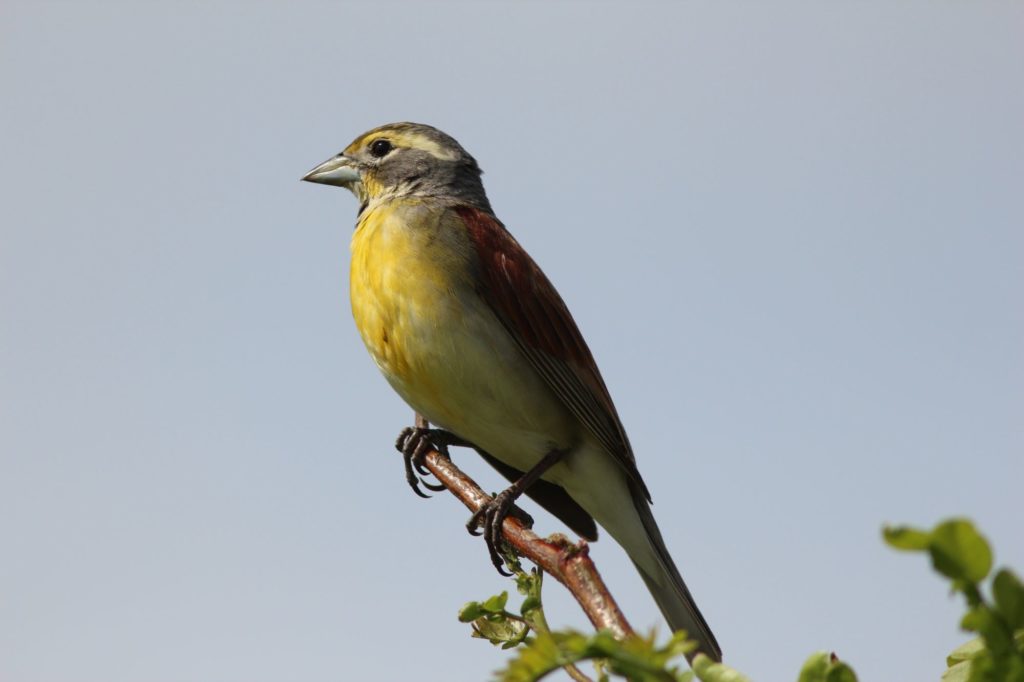Six a.m. Four teams. Maps in hand. GPS units operational. Our mission: conduct the annual grassland bird point count at Midewin National Tallgrass Prairie before the predicted thunderstorms roll in.

Midewin is a haven for grassland birds. It is, by an order of magnitude, the largest preserve in northeastern Illinois for a family of birds that is among the most imperiled on the planet. A primary reason for the sharp population decline for grasshopper sparrows, boblinks, and the like, is the loss of habitat. Only about 20 percent of Midewin is thus far restored to native prairie habitat. But the balance of the land – mostly pastureland, soybean fields and fallow farm fields – is managed in such a way to provide birds the habitat structure they need to nest and feed.
Monitoring bird populations lets Midewin staff know how they’re doing and helps inform management strategies.

This morning, Christopher Whelan, Grassland Bird Ecologist with the Illinois Natural History Survey, is our team leader. Rounding out the rest of team is Rachel, a seasonal Midewin staffer; Dave, an intern sponsored through the Student Conservation Association, and me, using a vacation day from my job as Director – Chicago Program for the Gaylord and Dorothy Donnelley Foundation.

Our monitoring begins in Tract 104, a tract I know well from having monitored it throughout the course of a couple of breeding seasons. During my solo counts, I would simply hike through the site for about an hour and a half counting every bird I see. Unlike these general counts, point counts are a more strategic means to estimate bird densities and population trends across entire large-scale areas, such as the 19,000 acres of Midewin. Point counts involve returning to the same point every year – that’s what the maps and GPS units are for – and then counting all the birds you see or hear within 100 metres, within five minutes.

Monitoring Tract 104 requires wading through grasses already thigh high. As usual, all the points within Tract 104 are teeming with bobolinks, dickcissels and grasshopper sparrows. Even more thrilling was the siting of a pair of sandhill cranes flying over head.

Immediately to the west, our next points are located in a field of former munitions storage bunkers. It takes a little more work to get to these points, as some of these areas have become shrubby with Osage orange sprouts and multiflora rose – both of which are riddled with stickers that snag and scratch. But even these scrubby areas have value for shrubland birds such as common yellowthroats, yellow warblers, brown thrashers and catbirds.
Further to the northwest, our assignment finally takes us into a restored area. Over the past few years, The Wetlands Initiative has returned an old, drained pastureland into a rich complex of prairie and wetland. The wet areas make for some difficult slogging, but the effort is worth it as our tally includes another pair of sandhill cranes, half a dozen great egrets, four American woodcocks, as well as a full complement of grassland birds.

Beyond the wading through high grasses, thorny patches and boot-sucking wetlands, the day was all the more challenging for the high winds of the approaching rains. This lessened the number of birds on the wing and made it more difficult to hear the subtler calls of, for instance, Hensolw’s sparrows.
Nonetheless, by my unofficial tally, our team saw 37 bird species before the rain put an early end to our morning. And then it was off to breakfast at the local diner in Wilmington – just about the time most folks would have been sitting down at their desks to start their day.
